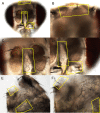Mating alters gene expression patterns in Drosophila melanogaster male heads
- PMID: 20937114
- PMCID: PMC3091707
- DOI: 10.1186/1471-2164-11-558
Mating alters gene expression patterns in Drosophila melanogaster male heads
Abstract
Background: Behavior is a complex process resulting from the integration of genetic and environmental information. Drosophila melanogaster rely on multiple sensory modalities for reproductive success, and mating causes physiological changes in both sexes that affect reproductive output or behavior. Some of these effects are likely mediated by changes in gene expression. Courtship and mating alter female transcript profiles, but it is not known how mating affects male gene expression.
Results: We used Drosophila genome arrays to identify changes in gene expression profiles that occur in mated male heads. Forty-seven genes differed between mated and control heads 2 hrs post mating. Many mating-responsive genes are highly expressed in non-neural head tissues, including an adipose tissue called the fat body. One fat body-enriched gene, female-specific independent of transformer (fit), is a downstream target of the somatic sex-determination hierarchy, a genetic pathway that regulates Drosophila reproductive behaviors as well as expression of some fat-expressed genes; three other mating-responsive loci are also downstream components of this pathway. Another mating-responsive gene expressed in fat, Juvenile hormone esterase (Jhe), is necessary for robust male courtship behavior and mating success.
Conclusions: Our study demonstrates that mating causes changes in male head gene expression profiles and supports an increasing body of work implicating adipose signaling in behavior modulation. Since several mating-induced genes are sex-determination hierarchy target genes, additional mating-responsive loci may be downstream components of this pathway as well.
Figures






Similar articles
-
A rapid genome-wide response to Drosophila melanogaster social interactions.BMC Genomics. 2007 Aug 22;8:288. doi: 10.1186/1471-2164-8-288. BMC Genomics. 2007. PMID: 17714588 Free PMC article.
-
Socially-responsive gene expression in male Drosophila melanogaster is influenced by the sex of the interacting partner.Genetics. 2011 Jan;187(1):157-69. doi: 10.1534/genetics.110.122754. Epub 2010 Oct 26. Genetics. 2011. PMID: 20980240 Free PMC article.
-
Neurogenetics of courtship and mating in Drosophila.Adv Genet. 2008;62:67-184. doi: 10.1016/S0065-2660(08)00603-2. Adv Genet. 2008. PMID: 19010254 Review.
-
Dynamic, mating-induced gene expression changes in female head and brain tissues of Drosophila melanogaster.BMC Genomics. 2010 Oct 6;11:541. doi: 10.1186/1471-2164-11-541. BMC Genomics. 2010. PMID: 20925960 Free PMC article.
-
Sexual behavior mutants revisited: molecular and cellular basis of Drosophila mating.Cell Mol Life Sci. 1999 Nov 15;56(7-8):634-46. doi: 10.1007/s000180050458. Cell Mol Life Sci. 1999. PMID: 11212311 Free PMC article. Review.
Cited by
-
Transcriptional profiles of mating-responsive genes from testes and male accessory glands of the Mediterranean fruit fly, Ceratitis capitata.PLoS One. 2012;7(10):e46812. doi: 10.1371/journal.pone.0046812. Epub 2012 Oct 11. PLoS One. 2012. PMID: 23071645 Free PMC article.
-
High fat diet induces sex-specific differential gene expression in Drosophila melanogaster.PLoS One. 2019 Mar 12;14(3):e0213474. doi: 10.1371/journal.pone.0213474. eCollection 2019. PLoS One. 2019. PMID: 30861021 Free PMC article.
-
Altering the sex determination pathway in Drosophila fat body modifies sex-specific stress responses.Am J Physiol Regul Integr Comp Physiol. 2014 Jul 1;307(1):R82-92. doi: 10.1152/ajpregu.00003.2014. Epub 2014 Apr 30. Am J Physiol Regul Integr Comp Physiol. 2014. PMID: 24789992 Free PMC article.
-
Comparative transcriptomics between Drosophila mojavensis and D. arizonae reveals transgressive gene expression and underexpression of spermatogenesis-related genes in hybrid testes.Sci Rep. 2021 May 10;11(1):9844. doi: 10.1038/s41598-021-89366-2. Sci Rep. 2021. PMID: 33972659 Free PMC article.
-
Identification of gene expression changes associated with long-term memory of courtship rejection in Drosophila males.G3 (Bethesda). 2012 Nov;2(11):1437-45. doi: 10.1534/g3.112.004119. Epub 2012 Nov 1. G3 (Bethesda). 2012. PMID: 23173095 Free PMC article.
References
-
- Dukas R, Mooers AO. Environmental enrichment improves mating success in fruit flies. Anim Behav. 2003;66:741–749. doi: 10.1006/anbe.2002.2261. - DOI
-
- Ueda A, Kidokoro Y. Aggressive behaviors of female Drosophila melanogaster are influenced by their social experience and food resources. Physiol Entomol. 2002;27:21–28. doi: 10.1046/j.1365-3032.2002.00262.x. - DOI
Publication types
MeSH terms
Substances
Associated data
- Actions
LinkOut - more resources
Full Text Sources
Molecular Biology Databases

